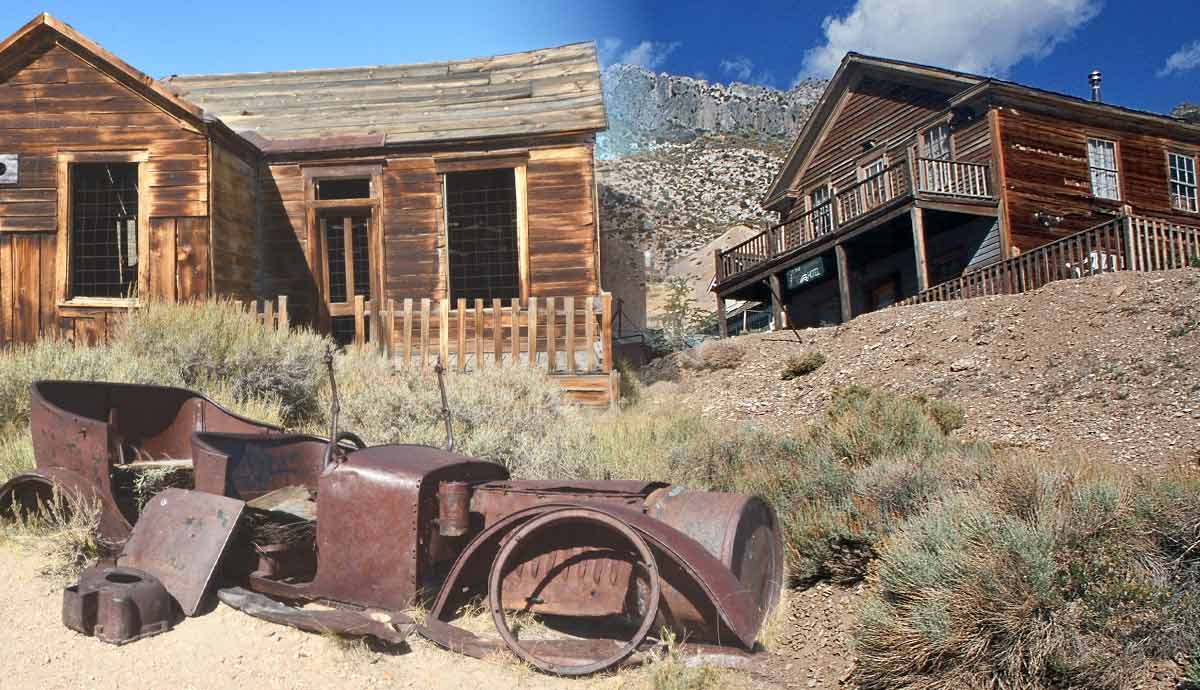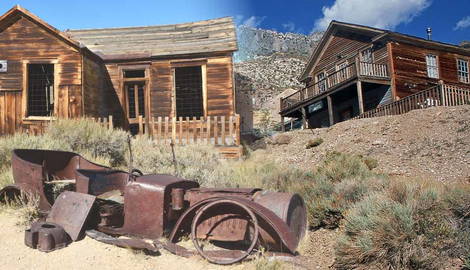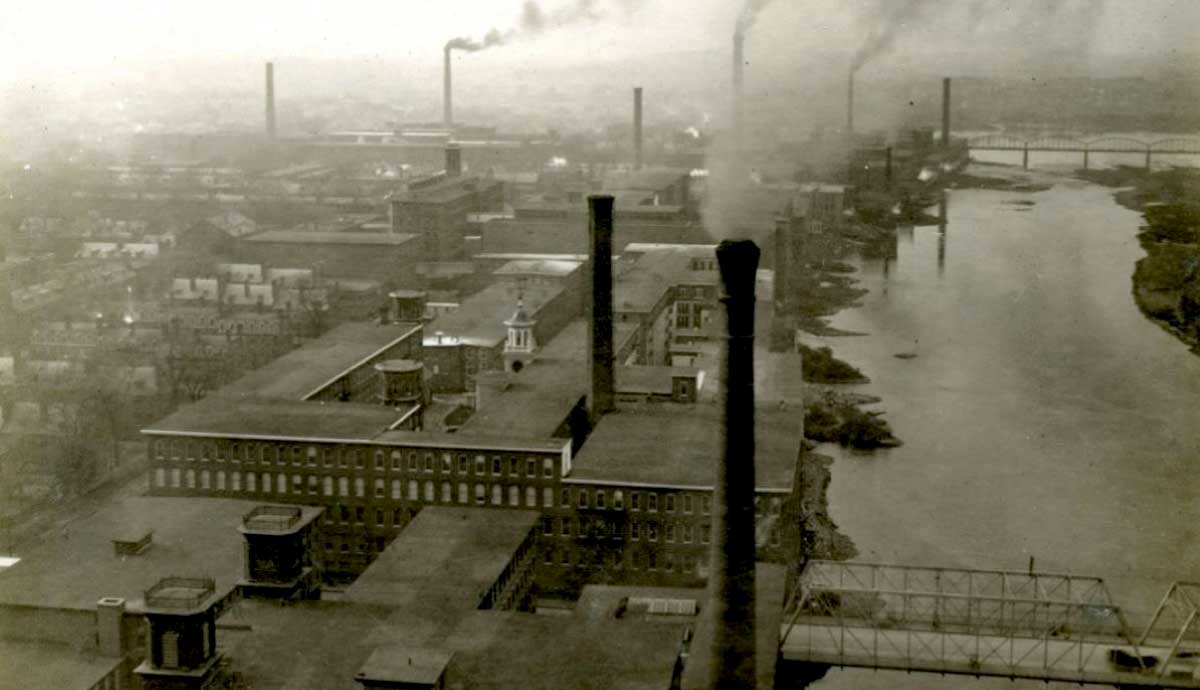
California’s history is as rich as the gold that once lured thousands to its rugged mountains and remote deserts. Scattered across the state are ghost towns that tell the stories of boom and bust, where fortunes were made and lost in the blink of an eye. These eerie remnants of a bygone era invite you to step back in time and explore the dusty streets, crumbling saloons, and abandoned mines that were once alive with the promise of wealth. Here are 10 of California’s most intriguing ghost towns that deserve a spot on your exploration list.
1. Ballarat

Established in 1897 as a supply hub for the mines in the nearby Panamint Mountains, this Californian desert ghost town quickly grew during the gold rush. It’s located in the Panamint Valley of Death Valley National Park and served over 500 residents at its peak.
Back in time, Ballarat featured seven saloons, three hotels, a jail, a school, and a post office. They all catered to adventurers and prospectors alike. But, as mining prospects dried up, the town was abandoned by 1917.
Ballarat’s remnants include today weathered stone structures, rusting trucks, and other relics that paint a picture of its vibrant yet fleeting past.
One of the most famous residents of Ballarat was Charles “Seldom Seen Slim.” He was a long-time hermit who lived in town until he died in 1968.
The town jail is one of the most notable historical sites to visit in Ballarat. This small stone building once held unruly miners and visitors. Another key landmark is the Ballarat Cemetery, which houses graves of early residents.
2. Cerro Gordo

This town is located in the Inyo Mountains of California and was a thriving silver mining town in the late 19th century. Cerro Gordo was founded in 1865 and quickly grew after local businessman Victor Beaudry acquired several mining claims and established essential infrastructure. This included a general store and the lucrative Union Mine.
By 1869, this historic Californian town became the largest producer of silver and lead in the United States, with mule teams transporting the wealth down to Los Angeles. This boom led to Cerro Gordo’s rapid expansion, which included numerous mining structures, saloons, and a hotel.
Several historical sites still remain today in town, and one of the most notable ones you should see when visiting is the original 1871 American Hotel. Other places to see include the 1904 Bunkhouse and the Belshaw House, which was built in 1868. As for the general store, it’s been turned into a small museum where you can learn about Cerro Gordo’s lively past.
Although there was a fire in 2020 that damaged several of these structures, efforts are ongoing to restore the site as a tourist destination.
When visiting Cerro Gordo, you’ll also have the chance to see remnants of the Inyo Mine and the Gordon House. The latter dates back to 1909, the town’s “zinc era.” It’s also worth exploring some of the other mining relics scattered throughout the area.
3. Calico

This historic ghost town is located in Southern California and was founded during one of the state’s largest silver strikes in 1881. Calico had 500 mines when it quickly boomed, producing over $20 million in silver ore. However, when silver prices plummeted in the mid-1890s, the town became deserted so quickly, actually, as fast as it had grown. By 1896, the once-bustling mining town was largely abandoned, leaving behind a few hardy residents.
Nestled in the Calico Mountains, this Californian historic town also faced many devastating fires during its early years. The most notable of these is the fire that occurred in 1884 when numerous structures were destroyed. Also, another major blaze in 1887 decimated 135 buildings. After this incident, many buildings were rebuilt using stone to prevent future fire damage.
In the 1950s, the founder of Knott’s Berry Farm, Walter Knott, purchased Calico and restored it to its former glory. He converted it into a tourist attraction where history lovers can experience the Old West. Today, the town is managed as a regional park, where you can enjoy tours, historical exhibits, and ghost town reenactments.
4. Bodie

Located in the high desert of California, Bodie is one of the best-preserved ghost towns from the Gold Rush era. The town was founded in 1859 after Waterman S. Body discovered gold. Since then, it transformed into a thriving boomtown in the 1870s. By 1879, Bodie had a population that peaked at around 10,000 and over 2,000 structures, including saloons, gambling halls, and opium dens.
But, as mining dwindled, the town declined, and by 1942, Bodie was completely abandoned. In 1962, the Californian town became a State Historic Park, preserved in a “state of arrested decay.”
When visiting Bodie today, you can explore several historical sites, including the Standard Stamp Mill, which processed tons of ore in the town. There’s also the Methodist Church, which is the only church still standing in Bodie. Don’t forget to visit the J.S. Cain House, which was home to Bodie’s richest resident, J.S. Cain. As for the Miners’ Union Hall, it is now a museum that showcases artifacts and memorabilia from Bodie’s mining past.
Other notable historical sites to visit in town include the Boone Store & Warehouse, the DeChambeau Hotel & I.O.O.F. Building, and the Lottie and Eli Johl House.
5. Johannesburg

This small, historic mining town is located in the high desert of Kern County, California. Johannesburg was established as part of the Rand Mining District in the 1890s alongside neighboring towns like Red Mountain and Randsburg. The town was named after the gold-rich Witwatersrand in South Africa. Its development was closely tied to the nearby mining activities, such as the King Solomon Mine, which is still a site you can visit today.
Thanks to the presence of the Randsburg Railway, Johannesburg became a bustling transportation hub at its peak. The railway was used to transport equipment, supplies, and ore for processing. Despite the fact that the railway tracks are long gone, you can still explore today the remnants of Johannesburg’s mining heritage. This includes the Old headframe of the King Solomon Mine as well as the Johannesburg Cemetery, where you can learn about the lives of past residents.
Some of the other notable historical sites you need to visit when in this historic Californian ghost town include the remains of the town’s early post office, boarding houses, music hall, and saloons.
6. Saltdale

Saltdale has a unique history rooted in salt harvesting. It’s a small, unincorporated community in California’s Kern County. It was founded in 1914 to extract salt from Koehn Dry Lake, a rare “moist” playa where groundwater naturally surfaced and deposited salt. In 1916, the Fremont Salt Company established the first saltworks there, followed by the Consolidated Salt Company, which took over in 1922. Saltdale’s production reached around 22,000 tons per year during its peak.
Fast forward to the late 1920s, and Saltdale has a company store, post office, and a small school for the children of the workers, despite the fact that the latter struggled with low attendance. Saltdale was relatively isolated, relying heavily on the Southern Pacific Railroad for the transportation of salt and other materials. Over the years, the town experienced several booms and busts, where it faced power and water shortages that hindered production.
At present, you can visit the mostly-abandoned town where you can see only remnants of its industrial past. This includes old foundations and traces of the salt ponds.
7. North Bloomfield

Located within the Malakoff Diggins State Historic Park in California, North Bloomfield is a well-preserved ghost town that was established in the mid-19th century. It originally bore the name “Humbug City” before becoming a prominent hydraulic mining town during the Gold Rush era.
The town grew around the Malakoff Diggins, the largest hydraulic mine in California, where powerful water jets washed away entire hillsides to extract gold. However, this technique caused significant environmental damage and led to landmark litigation that ended hydraulic mining in the 1880s, which contributed to North Bloomfield’s decline.
Today, you have the chance to experience the Gold Rush history when visiting this Californian ghost town. For instance, the Malakoff Diggins State Historic Park, which encompasses 3,143 acres, includes various historic sites such as the North Bloomfield Museum, a church, preserved homes, and the remnants of the mining operations.
You can enjoy the guided tours, which are available daily through October. They will take you through North Bloomfield’s original buildings and teach you about the rise and fall of hydraulic mining. The park also features guided gold panning experiences on Humbug Creek, so you might consider these as well.
8. Chinese Camp

This historic town in California was established during the Gold Rush era around 1849. English miners were those who initially founded Chinese Camp by employing Chinese laborers. The town quickly became a hub for Chinese mining companies as well as a community center for thousands of Chinese immigrants. It was home to over 5,000 Chinese residents at its peak and played a major role in the region’s mining operations.
Chinese Camp gained notoriety for being the site of California’s first recorded Chinese Tong War in 1856 between the Yan Woo and Sam Yap tongs.
When visiting this ghost town, you’ll have the chance to explore several notable historical sites, such as the St. Francis Xavier Catholic Church. The latter was established in 1855. This makes it the oldest church in Tuolumne County. Despite the fact that it was renovated, the church is now in a state of disrepair. However, it remains a key historical landmark.
Another preserved structure that you must visit in Chinese Camp is the old stone-and-brick post office, which was built in 1854.
It’s worth noting that Chinese Camp has been featured in several films thanks to its preserved historical buildings and rustic ambiance.
9. Jamestown

This historic Gold Rush town is located along the Highway 108/49 corridor in California’s Tuolumne County. Jamestown was one of the earliest settlements established after gold was discovered nearby at Woods Creek. This was in 1848. The Californian ghost town retains much of its Old West charm, with several original buildings dating back to the 1870s and 1880s. If you want to experience California’s Gold Country, then Jamestown should definitely be on your bucket list.
One of the most notable historical sites to visit in town is the Railtown 1897 State Historic Park. It’s known as “The Movie Railroad.” This landmark features the Historic Jamestown Shops and Roundhouse, where vintage steam locomotives are still maintained and repaired. Visitors can take guided tours here or ride the historic trains. The park’s locomotives have appeared in over 200 films, including “Back to the Future Part III” and “High Noon.”
Don’t forget to visit the historic Jamestown downtown, where you can see antique shops, restaurants, and local inns that offer you a glimpse into life during the Gold Rush era.
10. Amboy

You can find this small Californian ghost town along historic Route 66 in the Mojave Desert. It was originally founded in 1858 as a mining camp and became a significant stop in 1883 when it was established as the first in a series of alphabetical railroad solutions built across the Mojave Desert by the Atlantic and Pacific Railroad. Amboy reached its peak in the mid-20th century. It was all thanks to the rise of automobile travel along Route 66. During this period, the town was home to several businesses, such as cafes, motor courts, service stations, and a school.
The first iconic landmark you need to see when visiting Amboy is the Roy’s Motel and Café. This Route 66 fixture was opened in 1938. It served as a much-needed rest stop for travelers crossing the arid desert. Known for its distinct 1950s Googie-style neon sign, Roy’s became a symbol of Route 66’s heyday. Despite the fact that Amboy saw a decline after the Interstate Highway System was constructed, Roy’s has been preserved and restored by Albert Okura. The latter bought the town in 2005 and wants to revitalize it.










